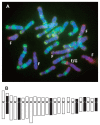Breeding of lilies and tulips-Interspecific hybridization and genetic background
- PMID: 29681746
- PMCID: PMC5903980
- DOI: 10.1270/jsbbs.17097
Breeding of lilies and tulips-Interspecific hybridization and genetic background
Abstract
Lilies and tulips (Liliaceae family) are economically very important ornamental bulbous plants. Here, we summarize major breeding goals, the role of an integrated method of cut-style pollination and fertilization followed by embryo rescue and mitotic and meiotic polyploidization involved in new assortment development. Both crops have been subjected to extensive interspecific hybridization followed by selection. Additionally, spontaneous polyploidization has played a role in their evolution. In lilies, there is a tendency to replace diploids with polyploid cultivars, whereas in tulip a majority of the cultivars that exist today are still diploid except for triploid Darwin hybrid tulips. The introduction of molecular cytogenetic techniques such as genomic in situ hybridization (GISH) permitted the detailed studies of genome composition in lily and tulip interspecific hybrids and to follow the chromosome inheritance in interspecific crosses. In addition, this review presents the latest information on phylogenetic relationship in lily and tulip and recent developments in molecular mapping using different DNA molecular techniques.
Keywords: GISH; Lilium; Phylogeny; Tulipa; chromosome; interspecific hybridization.
Figures







Similar articles
-
Chromosomal analysis of progenies between Lilium intersectional hybrids and wild species using ND-FISH and GISH.Front Plant Sci. 2024 Oct 22;15:1461798. doi: 10.3389/fpls.2024.1461798. eCollection 2024. Front Plant Sci. 2024. PMID: 39502926 Free PMC article.
-
Analysis of the meiosis in the F(1) hybrids of Longiflorum x Asiatic (LA) of lilies (Lilium) using genomic in situ hybridization.J Genet Genomics. 2008 Nov;35(11):687-95. doi: 10.1016/S1673-8527(08)60091-0. J Genet Genomics. 2008. PMID: 19022203
-
Production of polyploids and unreduced gametes in Lilium auratum × L. henryi hybrid.Int J Biol Sci. 2013 Jul 19;9(7):693-701. doi: 10.7150/ijbs.6427. Print 2013. Int J Biol Sci. 2013. PMID: 23904793 Free PMC article.
-
Biotechnological advances in Lilium.Plant Cell Rep. 2016 Sep;35(9):1799-826. doi: 10.1007/s00299-016-2017-8. Epub 2016 Jun 18. Plant Cell Rep. 2016. PMID: 27318470 Review.
-
Control of aphid-borne Lily symptomless virus and Lily mottle virus in Lilium in the Netherlands.Virus Res. 2000 Nov;71(1-2):23-32. doi: 10.1016/s0168-1702(00)00185-4. Virus Res. 2000. PMID: 11137159 Review.
Cited by
-
Identification of a Male Sterile Candidate Gene in Lilium x formolongi and Transfer of the Gene to Easter Lily (L. longiflorum) via Hybridization.Front Plant Sci. 2022 Jun 29;13:914671. doi: 10.3389/fpls.2022.914671. eCollection 2022. Front Plant Sci. 2022. PMID: 35845645 Free PMC article.
-
Chromosomal analysis of progenies between Lilium intersectional hybrids and wild species using ND-FISH and GISH.Front Plant Sci. 2024 Oct 22;15:1461798. doi: 10.3389/fpls.2024.1461798. eCollection 2024. Front Plant Sci. 2024. PMID: 39502926 Free PMC article.
-
High promoter sequence variation in subgroup 6 members of R2R3-MYB genes is involved in different floral anthocyanin color patterns in Lilium spp.Mol Genet Genomics. 2021 Jul;296(4):1005-1015. doi: 10.1007/s00438-021-01799-6. Epub 2021 May 30. Mol Genet Genomics. 2021. PMID: 34052932
-
Transcriptome Analysis by RNA-Seq Reveals Genes Related to Plant Height in Two Sets of Parent-hybrid Combinations in Easter lily (Lilium longiflorum).Sci Rep. 2020 Jun 3;10(1):9082. doi: 10.1038/s41598-020-65909-x. Sci Rep. 2020. PMID: 32494055 Free PMC article.
-
Multi-disciplinary evidence illuminates the speciation history of a monophyletic yet dimorphic lily group.Plant Divers. 2024 Dec 28;47(2):189-200. doi: 10.1016/j.pld.2024.12.005. eCollection 2025 Mar. Plant Divers. 2024. PMID: 40182484 Free PMC article.
References
-
- Abe, H., Nakano, M., Nakatsuka, A., Nakayama, M., Koshioka, M. and Yamagishi, M. (2002) Genetic analysis of floral anthocyanin pigmentation traits in Asiatic hybrid lily using molecular linkage maps. Theor. Appl. Genet. 105: 1175–1182. - PubMed
-
- Akutsu, M., Kitamura, S., Toda, R., Miyajima, I. and Okazaki, K. (2007) Production of 2n pollen of Asiatic hybrid lilies by nitrous oxide treatment. Euphytica 155: 143–152.
-
- Asano, Y. and Myodo, H. (1977a) Studies on crosses between distantly related species of lilies I. For the intrastylar pollination technique. J. Japan. Soc. Hort. Sci. 46: 59–65.
-
- Asano, Y. and Myodo, H. (1977b) Studies on crosses between distantly related species of lilies II. The culture of immature hybrid embryos. J. Japan. Soc. Hort. Sci. 46: 267–273.
-
- Asano, Y. (1980) Studies on crosses between distantly related species of lilies V. Characteristics of newly obtained hybrids through embryo culture. J. Japan. Soc. Hort. Sci. 49: 241–250.
Publication types
LinkOut - more resources
Full Text Sources
Other Literature Sources
